Picket Shots of Chickamauga with the Army of Tennessee
In "Picket Shots of Chickamauga" I'll share some of the shorter stories provided by veterans of the Chickamauga campaign that might not be long enough to constitute a blog post on their own, but make for insightful reading.
In commemoration of the 162nd anniversary of the second day of the battle, three accounts below give some perspectives from soldiers in the Army of Tennessee, including William Knight of the 36th Alabama who shares his memories of September 20th, George Jones war diary of Stanford's Mississippi Battery, and Captain John H. Martin of the 17th Georgia who 50 years later returns a corporal's commission he captured on the battlefield.
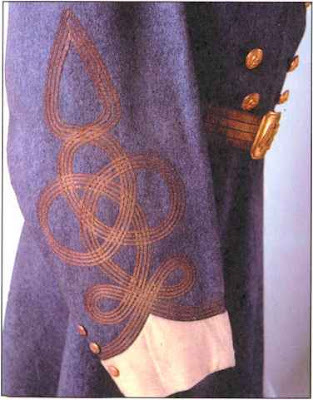 The detail of the lace on a uniform once worn by Lieutenant Braxton Bragg, commanding the Army of Tennessee at Chickamauga. The battle marked Bragg's one clear-cut victory over the Federals and it would be his last. His Army of Tennessee took enormous casualties defeating Rosey's bluecoats at Chickamauga and would be unable to full exploit that victory in the days afterwards. By the end of November, Bragg's army had been driven away from Chattanooga and Bragg asked to be relieved. Jefferson Davis finally agreed to do so.
The detail of the lace on a uniform once worn by Lieutenant Braxton Bragg, commanding the Army of Tennessee at Chickamauga. The battle marked Bragg's one clear-cut victory over the Federals and it would be his last. His Army of Tennessee took enormous casualties defeating Rosey's bluecoats at Chickamauga and would be unable to full exploit that victory in the days afterwards. By the end of November, Bragg's army had been driven away from Chattanooga and Bragg asked to be relieved. Jefferson Davis finally agreed to do so.
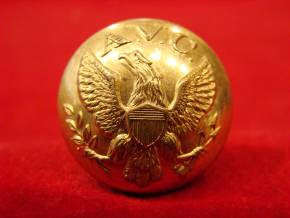 Alabama Volunteer Corps button
Alabama Volunteer Corps button
Chasing VanCleve’s Division in Clayton’s Alabama Brigade
The announcement of the death ofGeneral Henry D. Clayton vividly recalls to the mind of the writer the bloodyscenes of the Battle of Chickamauga where General Clayton fought so bravely anddistinguished himself so signally. The writer was a member of Co. C, 36thAlabama regiment but at this time was serving on General Clayton’s staff and isnow the only one of these staff officers that is left on this side of theriver.
His brigade was composed of the 18th,32nd, 36th, 38th, and 58th Alabamaregiment. The division was commanded by General Alexander P. Stewart ofTennessee. The battle was fought on the 17th, 18th, 19thand 20th days of September, 1863. During the last two days thehardest fighting was done and the heaviest losses sustained. Many of ourcompanies lost as many as 20 men and many of our bravest officers here pouredout their lifeblood. Among the number were Lt. Col. Richard Inge of the 18thAlabama and Major Jewett of the 38th. Lt. Col. Thomas H. Herndon wasseverely wounded and carried from the field.
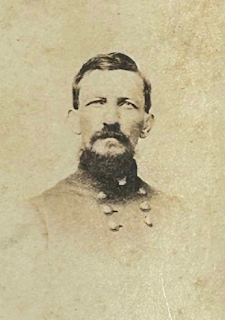 General A.P. Stewart
General A.P. Stewart"Old Straight"
On the 17th of Septemberthe first man was killed in the ranks of the 36th Alabama by acannon ball. The last charge was made on Sunday evening about 5 o’clock byClayton’s brigade on the division of Major General Van Cleve who was stronglyfortified behind a long line of breastworks constructed by cutting down largetrees. The charge resulted in a complete rout and almost entire capture of VanCleve’s division and ended the battle.
In the rear of van Cleve’s divisionwas a large old field and when the enemy were routed, this old field lookedlike a living mass of blue coats running pell-mell without regard to rank or file.It was here the gallant Clayton, followed by his staff and mounted men, dashedinto the midst and of the retreating mass and captured 4,000 prisoners; GeneralVan Cleve himself only escaping by possessing a fleeter horse than his pursuers,the officers of General Clayton’s staff. He finally reached the woods andsucceeded eluding us. I captured General Van Cleve’s portfolio, his papers, andphotograph, which I now have. I picked up on the battlefield a small bible withthe name of O.A. Mevis, St. Paul, Minnesota on one of the fly leaves and thefollowing epigraph: “The testament is of no force while the testator liveth.”If this soldier or any of his relatives are living and will write to me, I willgladly return it to them.
Source:
“Reminiscent:Recollections of Gen. H.D. Clayton at the Battle of Chickamauga,” CaptainWilliam N. Knight, Co. C, 36th Alabama Infantry, Troy Messenger(Alabama), November 7, 1889, pg. 1
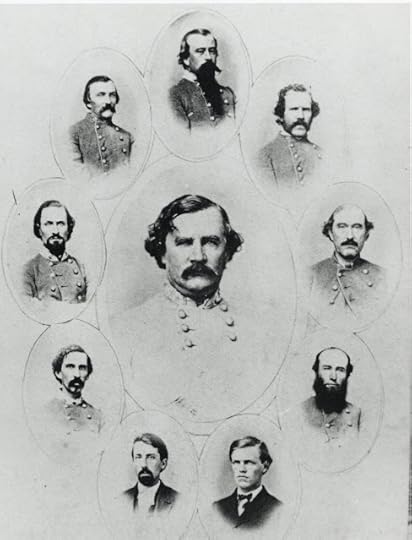 Division commander General Benjamin F. Cheatham and his staff in an image dating from 1863.
Division commander General Benjamin F. Cheatham and his staff in an image dating from 1863. War Diary ofStanford’s Mississippi Battery
Monday,September 7, 1863:Orders to march at a moment’s warning. Baggage packed in wagon at 10a.m. Ordersat 3 p.m. to be at McFarland’s, a distance of two miles, at sunset.
Tuesday,September 8, 1863:We rested our bones on the roadside last night; our horses remained standing inharness, ready to move in a moment. We are dirty as hogs. We moved off thismorning at 9, marching slowly, very dusty; marched 6 miles to Spring Creek;bivouacked in a large open field.
Thursday,September 10, 1863:At 8 o’clock we moved out from camp and marched two miles on the road toMcFarland’s, placed the guns in position, ready in case of attack on this road.Moved again at 8 o’clock tonight, crossed Chickamauga Creek about 10 o’clock.We are closing in upon the enemy; wouldn’t be surprised at a hard-fought battleany moment. General Rosecrans is said to have about 70,000 men.
Friday,September 11, 1863:We remained standing in the road all last night; moved again at sunrise;marched to the town of Lafayette, Georgia. It is now 4 p.m. The male academy isjust to our left.
Saturday,September 12, 1863:On the road at daylight; marched north to Rock Spring Church, 8 miles fromLafayette. Took position on the right of the road. Orders to build no fires.
Sunday,September 13, 1863:We stood by our guns all night; moved forward at sunrise. We advanced two mileson the Chattanooga road beyond our regular line of battle and took positionwhen we were ordered to shell the woods. We fired 70 times and did some goodshooting. We located a 10-lb rifle battery; they opened upon us and some oftheir shots came very close to us but most went over us. We fell back to themain line at dark.
Monday,September 14, 1863:Fell back to Lafayette again. We are marching and countermarching.
Wednesday,September 16, 1863:Ordered out on the road at 4 p.m. and marched one-and-a-half miles. We are nowcooking two days’ rations.
Thursday,September 17, 1863: Marchedout on the Ringgold road. Bivouacked at 10 p.m.
Friday,September 18, 1863:Moved forward a short distance at daylight. Heavy skirmishing throughout theentire day. Orders to stand by our guns.
Saturday,September 19, 1863: Itis now a little after daylight. We are moving in line of battle. We crossed theChickamauga this morning at 9 o’clock, having driven the Yankees from their strongposition. It is now 10 o’clock and the battle is raging all along the line. Ourright center is about to give way. There seems to be a gap between the left ofCheatham’s division and Hood’s right. Stewart’s division with our battery areheld in reserve and now are ordered to fill the gap. Oh, how awful, howfearful! It seems to be death itself. Stewart is making a gallant charge. Hehas broken the enemy’s center and is pushing forward. We are now under a heavy enfiladingfire. Our battery attempted to take a new position on a knoll of a ridge alittle in advance of the regular line. Just as we got nearly to the top of theridge a perfect hail of Minie balls and shells poured in on us. Wecountermarched in double quick time. Captain [Thomas J.] Stanford said to stay would meandeath to the entire battery in five minutes. John McNeal and Robert Burt werebadly wounded. It is now 4 p.m. A general advance is being made on the entireline. Volley after volley of musketry and the grand booming of artillery areheard all along the line. The Yankees are falling back slowly. It is now nearlydark. By 8 p.m., we are bivouacking on the bloody battlefield. General PrestonSmith was killed about dark while leading his brigade in a gallant charge.
Source:
“Old Soldier’sDiary: Mr. Geo. W. Jones’ Reminiscences Make Interesting Reading for Everybody,”Sergeant George W. Jones, Stanford’s Mississippi Battery, Grenada Sentinel(Mississippi), October 1, 1898, pg. 8
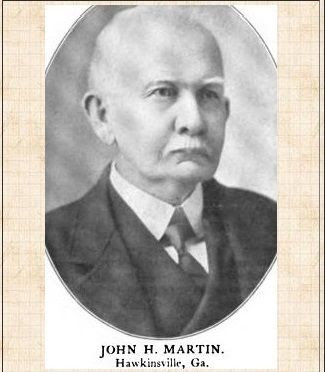 This postwar image of a determined looking Captain John Henry Martin of the 17th Georgia gives some sense of the character of this self-described "most unreconstructed Rebel you ever saw."
This postwar image of a determined looking Captain John Henry Martin of the 17th Georgia gives some sense of the character of this self-described "most unreconstructed Rebel you ever saw." Returning aBattlefield Trophy: a Letter from the 17th Georgia
In January 1913, Judge John HenryMartin of Hawkinsville, Georgia returned the long-lost corporal’s commission belongingto Thomas J. Rutledge, formerly of Co. F of the 8th Kansas Infantry.Martin had found it on the battlefield of Chickamauga on September 19, 1863,and wrote the following to Mr. Rutledge:
I was captain of Co. D, 17th Georgia Volunteers ofBenning’s Brigade, Hood’s Division, Longstreet’s Corps and we got to thebattlefield just after daylight on the 19th and were moved to ourextreme left, the Federal extreme right. Early in the morning of the 19th,Benning’s and Hood’s Texas Brigade were ordered to advance and did so. A friendof mine and I said we would be the first to strike the enemy and we dashedahead of the line and ran right into the 8th Kansas in the thickwoods. We ran right into the regiment and were captured for a short time.
Just after we got into the rear of the front of the regiment,a Federal soldier fired at me but a few feet distant but missed me and he waskilled. The fighting at this time was general and instead of the two sidesbeing in line, they were badly mixed up. Your side was holding up until a lotof Confederate cavalry with a yell dashed into the open on your right and rear(and our left). Then the Federals gave way and retreated, closely pursued byour troops and when our troops came up, I rejoined them.
We advanced up to the Lafayette road and by a cluster of oaksright be the side of the road where the Federals had had a battery; here I waswounded in the foot slightly. You will doubtless recollect where the batterywas located and when the cavalry dashed out. When the fighting stopped, I wentback to where I was shot at and found a dead man at the place as I near as Icould locate it. When the fellow shot at me, I did not notice him closely so asto certainly identify him for the fighting was then too furious forobservation. Close to this dead man was a knapsack which I took to be his andin the knapsack I found the commission and have had it ever since then. Ithought and have always thought until I got your letter that the owner of the knapsackand commission was the dead man and have so stated many times.
The next day, we moved to the right and were ordered to takean 8-gun battery that two or three brigades had tried in vain to take. We tookthe battery but lost nearly all our men. Every officer and man in my company waskilled, wounded, or hit with a ball. I was shot within 20 feet of the batterythrough my jaw, crushing it on both sides and from which I have never fullyrecovered. I was hit 11 times during the war, three of those wounds beingsevere. I was never in a Federal prison. I was captured on September 29, 1864,at Fort Harrison but got away as I had vowed that I would never surrender or betaken to a prison, preferring death. My company was captured by Lee’s surrenderbut I was not, being on detached duty near Danville, Virginia guarding theConfederate Cabinet against Federal raiders.
I was in skirmishes after Lee’s surrender and I have neversurrendered or been paroled but am today the most unreconstructed Rebel youever saw or heard of. I do not wear anything, except in midsummer, butConfederate gray. I do not, however, abuse or say hard things about the Federalsoldiers who fought us and some of my most loyal friends are old Federalveterans.
I know you will appreciate the commission and it will be amemento that you can leave your family.
Captain Martin died nine months later in Hawkinsville onSeptember 14, 1913, nearly 50 years to the day when he captured CorporalRutledge’s commission on the first day of the Battle of Chickamauga.
John Henry Martin was born April 10, 1842, in Decatur County,Georgia and enlisted in the 17th Georgia straight from college,entering the ranks a private but being quickly mustered as orderly sergeant. Hisservice record shows he was wounded at four battles: Second Manassas, July 2ndat Gettysburg, September 19th at Chickamauga, and May 6thduring the Wilderness. He was paroled May 20, 1865, at Thomasville, Georgia andreturned home where he became a judge.
Source:
“Lost in1863, Found in 1913. Commission dropped at Chickamauga Recovered,” Captain John Henry Martin, Co. D, 17th Georgia Infantry, Coffeyville Daily Journal(Kansas), January 22, 1913, pg. 6
To learn more about the Chickamauga campaign, please check out the Battle of Chickamauga page where you'll find more than 100 blog posts covering varying aspects of this important campaign.
Daniel A. Masters's Blog
- Daniel A. Masters's profile
- 1 follower



